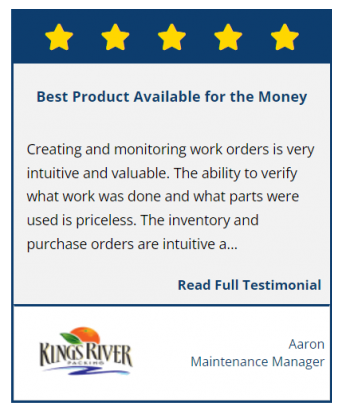
When an individual in a service department with a traditional mindset considers the possibility of implementing a computerized maintenance management system (CMMS) to modernize their processes and enter the 21st century, the term “bean counting” is typically the first thing that comes to mind for most people. Why do honest, hardworking people get nervous about implementing a CMMS? What exactly is “bean counting” and how do you avoid it?
What is Bean Counting?
Bean counting is when the cost and aggravation of measuring a metric is not worth the value that it brings to the service department. This often occurs when managers and directors become too fixated on metrics and lose sight of the larger picture. When this happens, they may overlook the potential benefits of implementing a CMMS and instead focus solely on the numerical data. However, by prioritizing bean counting over the overall value of the CMMS, they risk missing out on opportunities to improve maintenance practices and reduce costs in the long term. To avoid this, it is essential to implement a CMMS that delivers benefits to all stakeholders, including management, workers, support staff, and customers, by making it user-friendly and efficient, streamlining and optimizing everyone’s work.
Risks of Bean Counting in Maintenance Management

The practice of bean counting in maintenance management can give rise to a limited perspective that is fixated solely on numerical metrics, such as completed work orders, maintenance expenses, and equipment downtime while overlooking the larger context. This approach can result in a lack of understanding of the overall value that a maintenance management system can provide, such as improved maintenance operations, enhanced decision-making processes, and better support for all stakeholders, including management, workers, support staff, and customers.
Managers and directors risk missing out on potential chances to enhance maintenance procedures and save costs by focusing solely on the quantitative components of maintenance management. It is critical to understand that the entire value of a maintenance management system extends beyond the quantitative gains, and that qualitative factors such as staff engagement, customer happiness, and organizational culture are as significant.
As a result, for best maintenance management outcomes, a balanced strategy including both quantitative and qualitative data is needed. This strategy ensures that all stakeholders are satisfied with the system’s performance and that the benefits of a maintenance management system are fully realized.
Avoiding The Risks of Bean Counting
When it comes to maintenance management, it’s important to avoid the risks of bean counting. This term refers to a narrow focus on financial metrics, such as cost and ROI, at the expense of other important factors like quality, safety, and long-term sustainability. While it’s essential to keep track of expenses and allocate resources efficiently, it’s equally important to consider the broader context of maintenance activities. This includes factors like asset lifespan, maintenance history, and the overall impact on organizational goals and objectives. By taking a more holistic approach to maintenance management, organizations can avoid the risks of bean-counting and make better-informed decisions that support long-term success.
In addition to considering the broader context of maintenance activities, it’s also essential to recognize the value of preventive maintenance. By proactively addressing potential issues and performing routine inspections and maintenance, organizations can avoid costly downtime and equipment failures down the line. This approach requires a shift away from reactive maintenance, which tends to focus on fixing problems after they occur rather than preventing them from happening in the first place. By investing in preventive maintenance, organizations can not only save money but also improve the safety and reliability of their assets, leading to increased productivity and better overall outcomes. Ultimately, by taking a more strategic and comprehensive approach to maintenance management, organizations can avoid the risks of bean-counting and achieve long-term success.
With over 30 years of experience helping service departments with their CMMS needs, I can confidently say that every service department is unique and has its own set of strengths and challenges. While it may be tempting to compare your goals and strategies to other departments, it’s important to recognize that a one-size-fits-all approach simply doesn’t work. Each department is composed of individuals of different ages, backgrounds, and personalities, which can make collaboration a challenge. When implementing a CMMS system, it’s crucial to take into account the specific needs and circumstances of your department to create a tailored approach that maximizes efficiency and productivity. By embracing the unique qualities of your team and customizing your CMMS goals, you can achieve great success and drive your department forward.
Every organization has its own unique culture and working environment, ranging from highly competitive and political to more relaxed and friendly. As a manager, it’s important to consider these factors when implementing a CMMS system and setting goals for your team. If you recognize that you may not have all the necessary expertise, it’s wise to seek out the advice of knowledgeable individuals to help you establish practical and realistic goals. By setting short-term objectives that are attainable, you can demonstrate the tangible benefits of using a CMMS and build momentum for further improvements. After several months of implementation, it’s important to evaluate the success of your plan and consider whether new goals are worth pursuing. It’s important to involve your team in the process and ensure that any new goals align with the overall benefit of the organization and do not create unnecessary burdens. By taking a thoughtful and collaborative approach to CMMS implementation and goal-setting, you can maximize the benefits for your team and organization.
The Goal
To achieve success with your CMMS system, it’s essential to invest effort and resources into it with a clear purpose in mind. Rather than just collecting data for the sake of it, a thoughtful and tailored approach can ensure that your CMMS delivers tangible benefits to your service department. With careful planning and implementation, a CMMS can boost staff morale and enhance overall performance. While some managers may have concerns about CMMS implementation, it’s important to differentiate between genuine issues and unfounded claims of bean counting. Every service department is unique, and there’s no one-size-fits-all approach to CMMS implementation. As someone with extensive experience in this field, I can attest to the importance of customizing your CMMS to suit the specific needs and circumstances of your department. By doing so, you can achieve a successful CMMS system that brings real value to your organization.
To achieve a successful implementation of a CMMS, it’s important to focus on creating a team that will work together to establish sensible goals that benefit everyone. Bean counting, which occurs when the cost of measuring and recording information exceeds its benefits, can be avoided by hiring a sensible and experienced consultant who can offer gentle guidance and advice. Before hiring a consultant, it’s important to assemble a team that includes workers and support staff, as well as a few friendly customers, and to check the references of any consultant to ensure they have a track record of honesty and integrity. By setting achievable goals and working together as a team, you can avoid bean-counting and achieve a successful CMMS implementation that makes everyone’s work easier.
Final Thoughts
In maintenance management, bean-counting or tracking financial metrics such as maintenance costs and return on investment is crucial for assessing the effectiveness of maintenance activities. However, it is important to avoid the pitfalls of over-reliance on bean counting by also considering qualitative factors such as equipment downtime, maintenance backlog, and employee productivity.
By taking a more holistic approach to maintenance management that considers both financial and non-financial factors, organizations can make informed decisions that optimize maintenance performance and drive overall business success. This involves developing a strategic maintenance plan that aligns with organizational goals and priorities, and regularly reviewing and adjusting maintenance activities based on performance metrics and feedback from employees and customers.
In conclusion, while bean counting is an essential part of maintenance management, it should not be the sole focus. By taking a broader perspective and considering both quantitative and qualitative factors, organizations can achieve a more balanced and effective approach to maintenance management that delivers sustainable results.